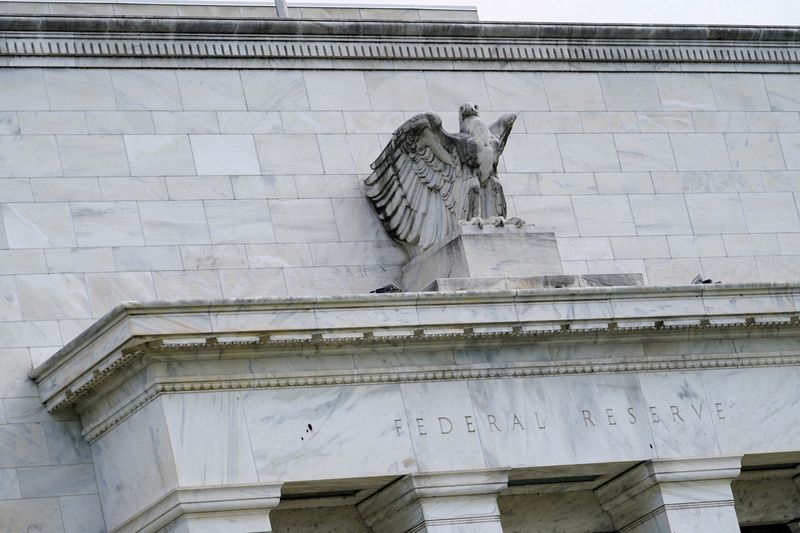By Jamie McGeever
ORLANDO, Florida (Reuters) – After grappling with the strongest U.S. value pressures in 4 a long time, it is laborious for buyers to regulate to the notion that inflation may quickly undershoot the Federal Reserve’s 2% goal.
However they need to.
Whereas traversing the “last mile” in inflation’s retreat to 2% is proving to be sometimes arduous, warning indicators are flashing that the largest danger for markets and policymakers isn’t “higher-for-longer” inflation, however the digital disappearance of value pressures.
Falling short-term common inflation metrics, slumping commodities costs, a softening labor market, and cooling wage pressures are all pointing a method: disinflation.
Whereas the August employment report on Friday added some gas to this hearth – payrolls development got here in beneath expectations whilst wage development accelerated and the unemployment fee ticked decrease – the response in monetary markets added much more.
Bond yields tumbled, the yield curve steepened sharply and oil costs slumped. At one level, charges futures markets had been leaning in direction of the Fed slicing charges by 50 foundation factors later this month and by virtually 250 bps by the tip of subsequent yr, an indication of the disinflationary forces merchants had been pricing in.
This response is in step with historical past. The Fed has carried out easing cycles of 250 foundation factors or extra 4 occasions since former Fed Chair Alan Greenspan took over as head of the U.S. central financial institution in 1987. Each one has been related to a fast decline in inflation, three of them ending in important undershoots of the Fed’s 2% goal.
COMMODITY WARNING BELLS RING
Globally, disinflationary pressures have been intensifying for a while, particularly within the euro zone and a few key rising markets, like India and Indonesia. And China is battling towards outright deflation.
In the meantime, futures have posted their lowest shut since December 2021. Remarkably, oil is down virtually 25% from a yr in the past – a major fall that can assist depress general value pressures when imputed into subsequent yr’s inflation calculations.
Oil and commodity costs have much less of a direct influence on U.S. inflation than they did 20 or 30 years in the past. The financial system is extra services-oriented and fewer industry-intensive than it was once, and the U.S. is now a web oil exporter. Nonetheless, U.S. gasoline futures are at their lowest stage since March 2021, having fallen practically 15% final week alone.
Value swoons like that can not be ignored and can put downward strain on inflation. So will wages, the largest single price for many firms in America, because the labor market deteriorates.
BALANCE OF RISKS
After all, there are counter indicators indicating that U.S. development continues to be buzzing alongside at a remarkably sturdy tempo contemplating the place we’re within the financial cycle.
The dominant companies sector continues to broaden at a wholesome clip, retail gross sales in July rose greater than thrice quicker than anticipated, and the Atlanta Fed’s GDPNow mannequin continues to be pointing to GDP development of two.1% within the third quarter.
On the similar time, shelter inflation – a proxy for the price of housing – continues to be working at a sticky 5%. The longer headline and core annual inflation stay above 2%, the better the danger that client inflation expectations will keep elevated.
However when contemplating the place nearly all of tendencies are pointing, it’s clear the steadiness of dangers is shifting away from inflation and towards development.
“If it is a ‘soft landing,’ the return to 2% will be gradual. If it is something more damaging, the risk of an undershoot will be significant,” says James Knightley, chief worldwide economist at ING.
PARADIGM SHIFT?
It’s also price remembering how a lot the Fed – and different developed market central banks – struggled to get inflation again as much as 2% within the decade following the International Monetary Disaster. Most of the tendencies believed to underlie that wrestle – like ageing demographics – haven’t modified.
And whereas spending on expertise may spur development within the years forward, developments in synthetic intelligence ought to, in idea, put downward strain on costs. So with a view to settle for that U.S. inflationary dynamics actually have shifted, one must consider that globalization is in sharp retreat, power markets will proceed to fracture and protectionism will preserve rising.

That might be true, however it’s hardly an open-and-shut case. The notion that U.S. inflation may undershoot the Fed’s goal – and keep low – has been nearly unthinkable for a lot of the post-pandemic interval, however it’s now very a lot within the realm of risk.
(The opinions expressed listed below are these of the writer, a columnist for Reuters.)
(By Jamie McGeever; Modifying by Paul Simao)




